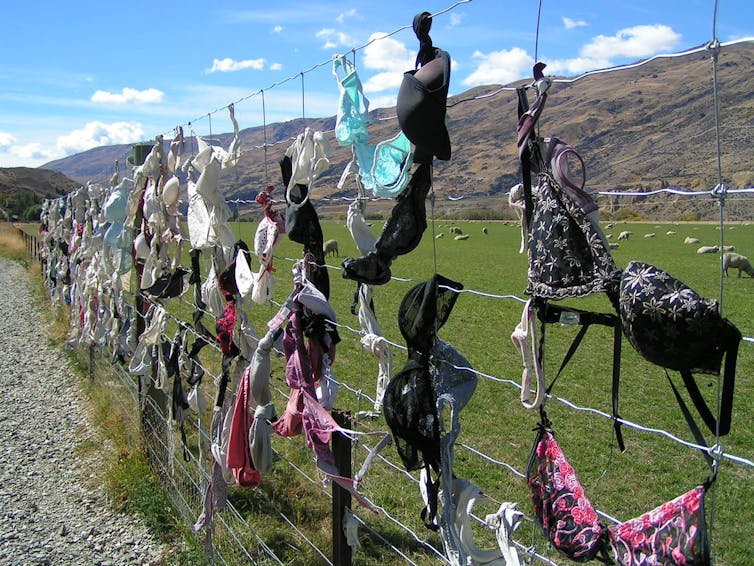
Lea Budden, James Cook University
Women’s breasts are seen in society as symbols of femininity, fertility and sexuality – so are the many different styles of bras worn to support, enhance and protect the mammary glands.
Many women wear bras to bed to support large, painful or nursing breasts. Others just want to counteract any sagging. But can these decorative pieces of clothing, or the underwire, cause health problems such as cancer?
Breast cancer is the most common cancer in Australian women. More than 12,000 women each year are diagnosed with the disease, with the overall risk estimated at one in nine.
Most women will meet someone during their lifetime who has been affected by the disease and its treatment. So it’s easy to see why women may be anxious about the risk of breast cancer.
What is breast cancer?
Humans are made up of millions of cells (which contain components such as DNA, chromosomes and genes) that form specialised tissues and organs such as breasts. Women’s breasts consist of lobules (mammary glands producing milk), ducts (tubes) and fatty tissue.
When abnormal cells (cancer) grow in the body, an immune response is triggered and these cells are killed. If the body doesn’t recognise these foreign cells they multiply and start to invade other cells, tissues and organs in the body. These cancer cells then multiply into tumours or lumps in the body – or in the case of breast cancer, form lumps in breast tissue.
Depending on their size, these lumps can sometimes be felt or seen on mammography screening. Or they may be detected using ultrasounds or biopsies. Other signs of breast cancer include:
- changes to breast shape or size,
- breast dimpling, rash or other skin changes,
- lumpiness or thickening of the breast,
- unusual or persistent breast pain,
- nipple sores or discharge,
- swelling or discomfit in armpit.

What causes breast cancer?
The cause of breast cancer is still unknown. However, there are some known causes for other cancers such as lung cancer, such as asbestos exposure. Factors that cause cancer are called carcinogens – these include: tobacco, alcohol, ultraviolet sunlight, radon exposure (radiation), chemical agents such as formaldehyde and contaminated water containing arsenic.
Women’s risk of developing breast cancer increases with age (over 50 years). Other risk factors include:
- personal history,
- family history,
- inheritance of mutations in the genes BRCA2, BRCA1 and CHEK2,
- exposure to female hormones (natural and administered),
- obesity (poor diet and inadequate exercise), and
- excess alcohol consumption.
Cancer Australia’s website has a very quick and easy tool to help women calculate their risk of developing breast cancer. It also includes advice about reducing your cancer risk through lifestyle modifications such as reducing alcohol consumption, maintaining a healthy weight and diet, regular exercise and mammograms for women over 50 years.
Treatment
The treatment of breast cancer depends on the stage at which it is detected. Women diagnosed with early breast cancer are usually offered a choice of either breast conservation surgery (lumpectomy-removal of the breast lump) with radiotherapy or mastectomy surgery (removal of the breast). Other treatment (sometimes called adjunct treatment) for breast cancer may include chemotherapy, axillary clearance (removal of affected lymph nodes) and hormonal therapy.
It’s important to remember that breast cancer does occur in younger women. So if you notice any breast changes or are concerned about your risk, don’t hesitate to consult your doctor. Early detection of breast cancer is likely to improve the outcomes of treatment.But rest assured, there is no evidence that wearing bras – with or without underwires, during the day or at night – increases your risk of breast cancer.![]()
Lea Budden, Senior Lecturer School of Nursing, Midwifery & Nutrition, James Cook University
This article is republished from The Conversation under a Creative Commons license. Read the original article.

